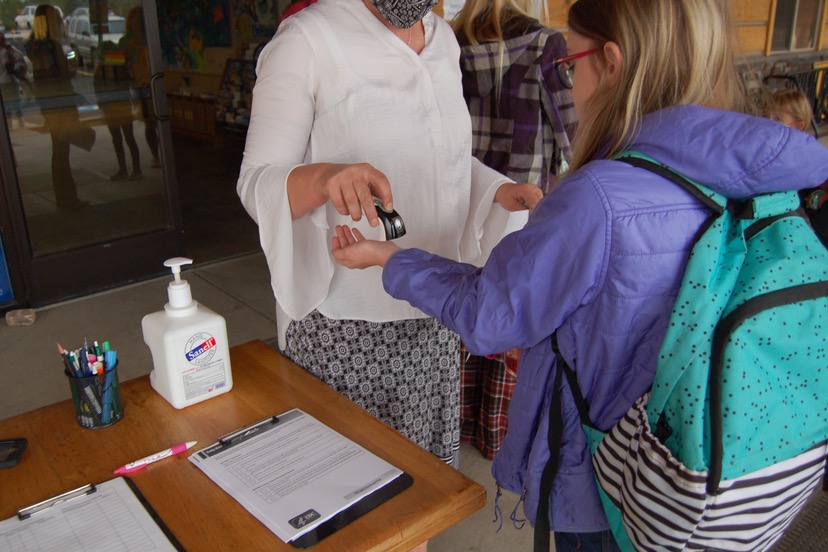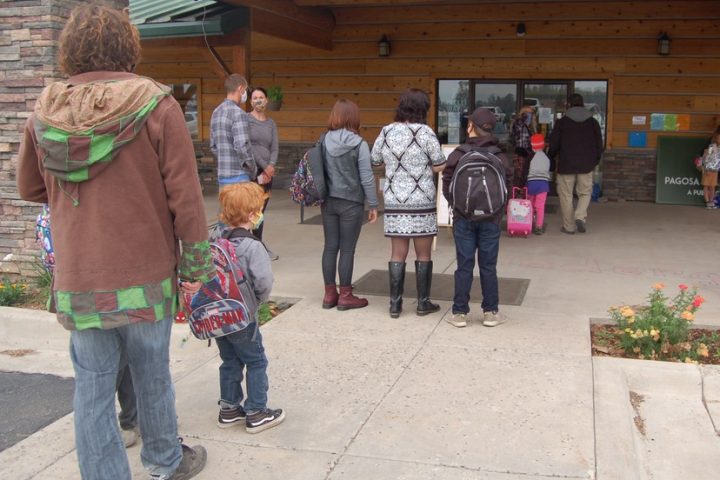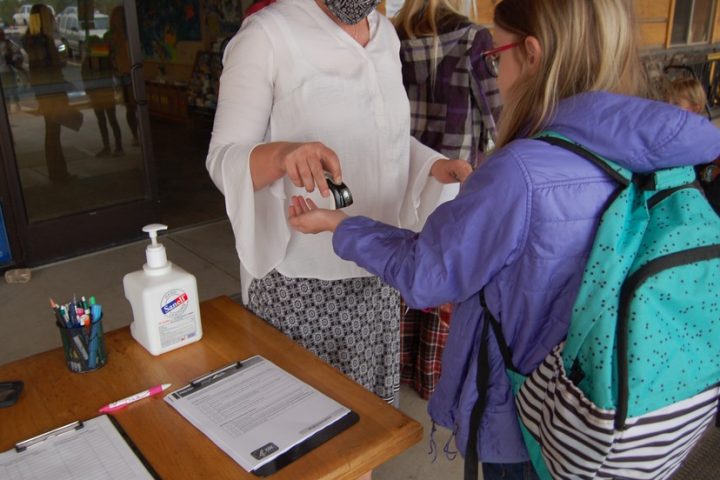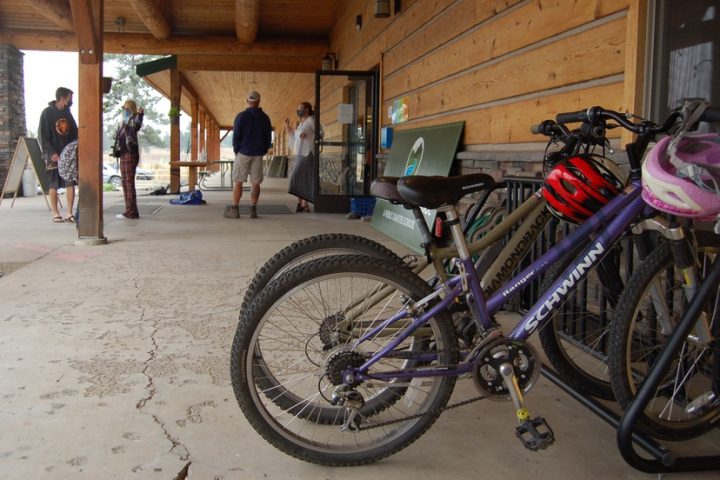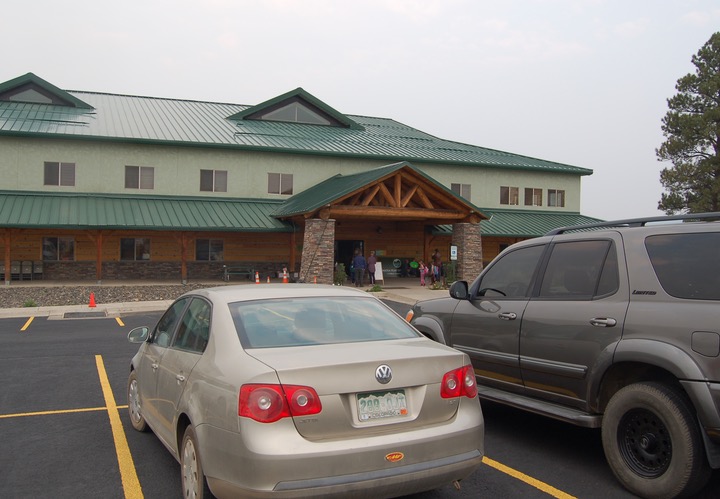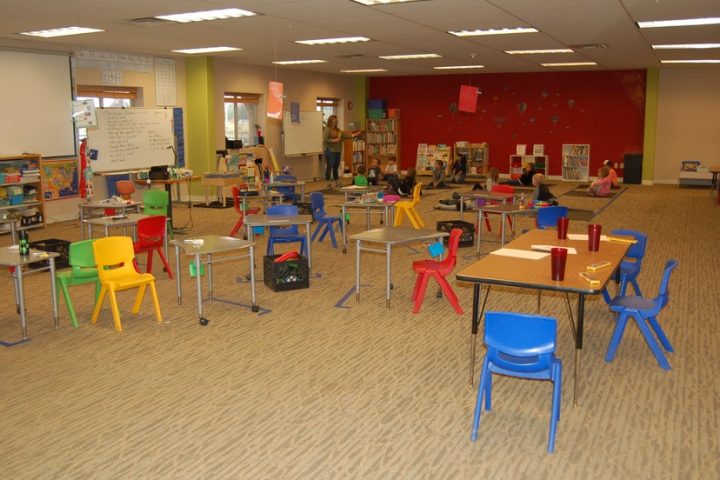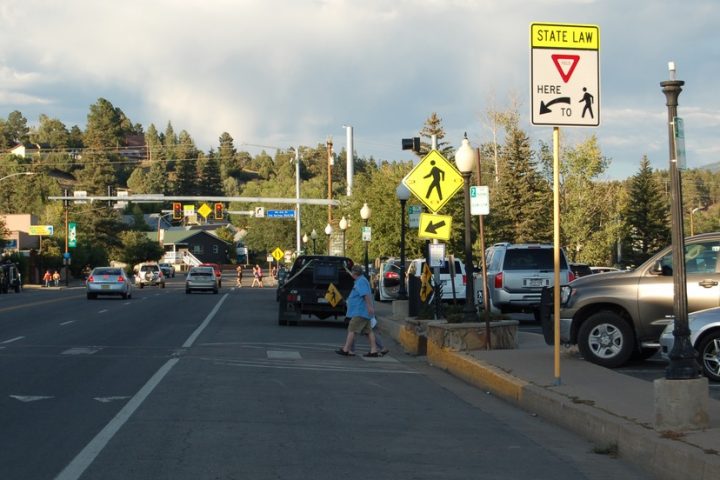In Parts One and Two of this editorial series, we looked at the approval by the Pagosa Springs Town Council, of a plan to create official ‘School Zones’ surrounding most of our local educational institutions, with the goal of making motorists more aware of the pedestrian crossings used by children before and after school… or possibly, more aware of children arriving at school in buses or vehicles, or gathered near school buildings to load into buses or parents’ vehicles. The creation of ‘official’ zones will also allow our Police Department to issue higher-priced speeding tickets, and defend those higher prices in court.
I stopped by the Pagosa Peak Open School (PPOS) on Tuesday morning, to snap a few pictures of the “First Day of School During a Pandemic”. Most people were wearing masks, and they waited, socially distanced, to check in. Temperature checks were planned to be a part of the morning process.
As far as I could tell, only one of the families rode their bikes to school; everyone else arrived in a car or truck. (Charter schools do not typically provide school bus service.)
Five years ago, when the Pagosa Charter School Initiative first selected the Parelli Building as its preferred site for a proposed K-8 public charter school built around a ‘Project Based Learning’ educational model, the group imagined that the 34,000 square-foot office building would have plenty of room for not only the school, but possibly also for a preschool and maybe other community non-profits.
But initially, the school needed to lease space in the building, part of which was still being used by the Parelli Natural Horsemanship organization.
The group also imagined that it would take five years of operations — or more — before the charter school would be able to purchase the entire building. But thanks to help from the Colorado Department of Local Affairs, the Town of Pagosa Springs, the USDA Rural Development agency, and a generous private donor, Pagosa Peak Open School was able to buy the building this past May — in the midst of a pandemic.
And rather than lease out the extra space that became available with the departure of the Parelli organization, PPOS made the decision to address the health challenges posed by the pandemic by spreading its student body throughout the entire building. Social distancing on steroids, you might say.
Here, for example, is Ms. Kelle Bruno’s 1st grade class… 14 students in a room that allows for plenty of social distancing.
One of the changes at PPOS, as the school begins its fourth year, will be the provision of ‘Free and Reduced Lunches’ aligned with the school’s ‘food security’ policies. Sufficient food, and proper nutrition, certainly play an essential role of a community’s overall evolution… when ‘health’ is a shared goal. And if the COVID pandemic has caused anyone to rethink the idea of ‘personal health’, it’s likely become more clear that each of us is healthier when all of us are healthier.
Daily Post contributor Cynda Green, meanwhile, is fond of reminding me that walking — daily, for exercise — has generally been endorsed by medical experts as beneficial to a person’s health. In that regard, I feel fortunate that the Town of Pagosa Springs has consistently embraced a program of trail development and the creation of a “pedestrian friendly” downtown, since I moved here in 1993.
Pagosa Springs has also been fortunate in terms of youthful pedestrians getting struck by motorists, over the past 27 years. I recall hearing of only two cases where a young person was hit by a vehicle. Both cases occurred along Highway 160, when the young person was crossing (carelessly?) at a pedestrian crossing. In neither case was the person seriously injured… as I recall.
But that is merely a number. “Two people.”
Why is that number so low? (Assuming that “two” is a low number in a town our size.) Part of the reason must be that children — and adults — no longer do much walking in Pagosa Springs, unless they own a dog. The number of cars and trucks plying our highway and streets here has increased substantially since 1993, but the number of people walking, I do believe, has declined. The folks who seem to do the most walking, in Pagosa, are the tourists. And they are often crossing busy streets at the most precarious locations.
But the ongoing campaign by the Town government to re-create a ‘pedestrian-friendly’ downtown — the type of walkable, safe downtown that many of us moved here to enjoy, decades ago when Pagosa had only a single stoplight — has been at odds with the actions of the Archuleta County government, which spent those same decades approving a series of sprawling “not-pedestrian-friendly” suburban subdivisions totally dependent upon automobile transportation. As a result, 85% of the community lives in places where they cannot walk to school, cannot walk to work, cannot walk to the grocery store, cannot walk to church… cannot walk to pretty much anything. And the sprawling distances also make effective public transportation nearly impossible. Obviously, public health was low on the list of priorities for the Archuleta Board of County Commissioners for several decades.
Yes, our suburban residents can walk the golf course (for a small fee?) And yes, they can hike the trails in the National Forest, and ski the trails at Wolf Creek Ski Area.
And yes, those are all healthful activities.
But most of our community will never be “pedestrian-friendly”, I’m afraid.

